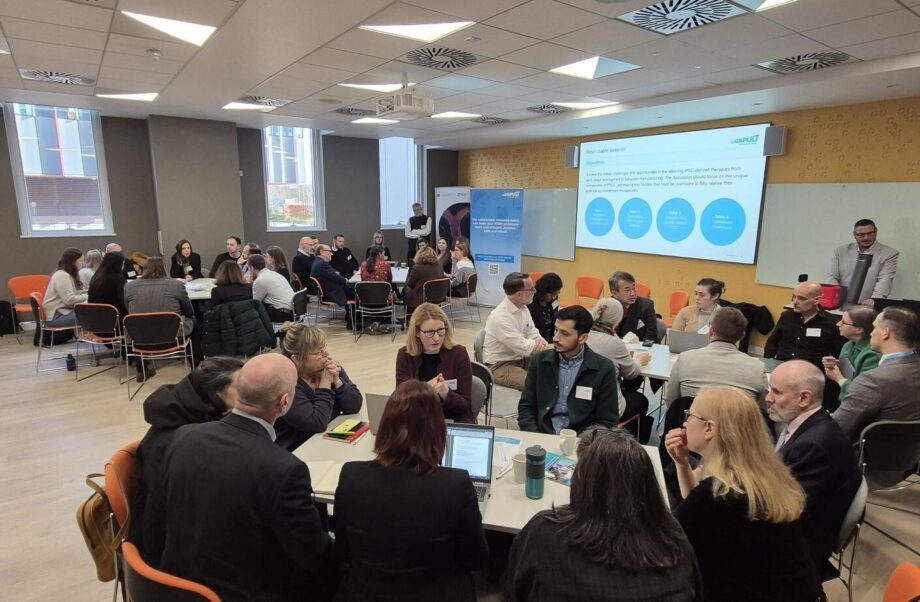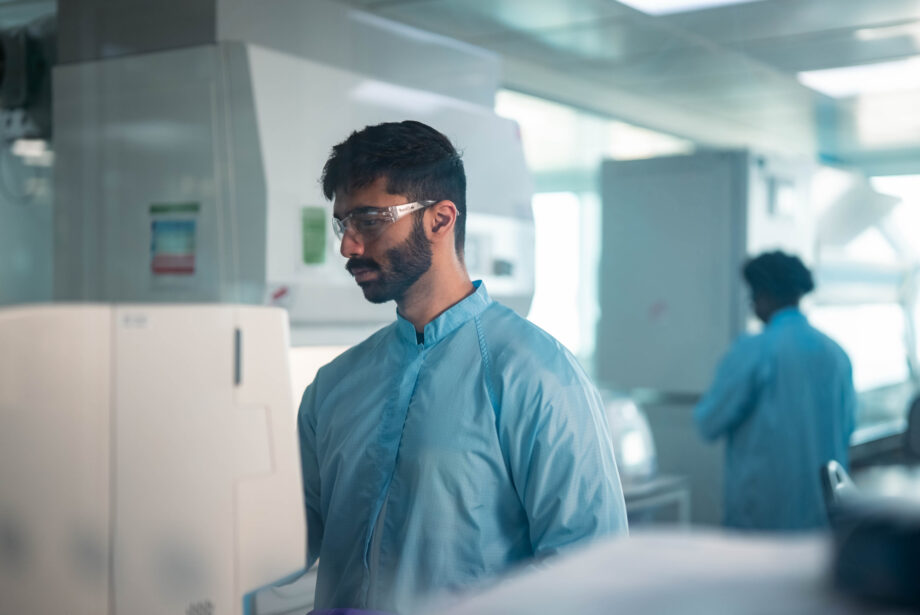In February 2025, the Cell and Gene Therapy Catapult hosted a roundtable discussion which brought together experts from academia, industry, and regulatory agencies to identify key barriers and propose actionable strategies to accelerate progress.
Summary
The discussion focused on five key areas affecting iPSC therapy development, identifying the associated challenges and suggesting potential solutions:
Regulatory harmonisation and guidance: Harmonised global regulations, collaborative forums, early engagement with regulators, and clear QC criteria are needed to streamline iPSC therapy approvals and ensure quality.
Manufacturing scale up and automation: Achieving scalable iPSC manufacturing requires modular platforms, automation, clear guidelines, and strengthened public-private partnerships to address financial and regulatory hurdles.
Quality control and analysis: Robust QC strategies focused on safety, potency and standardisation, alongside flexible regulatory approaches, are critical for the success of iPSC therapies.
Raw materials and supply chain: Ensuring consistent supply of high-quality raw materials requires standardisation, rigorous qualification, and collaboration with suppliers, supported by clear terminology and robust backup strategies.
Translational ecosystem and collaboration: Bridging research, industrial development, and healthcare adoption through funding, partnerships, improved regulatory guidance, and stakeholder education will help to advance iPSC therapy development and commercialisation.

Introduction
Induced pluripotent stem cells (iPSCs) represent a transformative technology for regenerative medicine, offering a renewable source of patient-specific or universal therapeutic cells. However, the transition from research to routine clinical application remains challenging.
In this article, Daniel Gibson, Head of Collaborations at the CGT Catapult, outlines key insights from the discussion, focusing on regulatory harmonisation, manufacturing scale-up, quality control, supply chain considerations, and broader ecosystem challenges.
Regulatory harmonisation and guidance
The regulatory environment for iPSC-derived therapies remains fragmented globally. Variations in how different jurisdictions evaluate safety, potency, and product quality introduce uncertainty, making it difficult for developers to align development strategies across regions.
The roundtable emphasised the value of early, iterative engagement between regulators and developers, such as through regulatory sandboxes or informal pilot programs, which allow feedback before formal submissions. While countries like the UK support such informal non-binding interactions, these are not as readily available in other countries such as the US, leaving companies with limited guidance options during early development.
Participants advocated for structured opportunities, like workshops or dedicated meetings, to discuss innovations in iPSC manufacturing, such as novel genome editing steps, with regulators to clarify expectations and reduce development risks. Sharing insights from these discussions publicly could benefit the broader field. Technical grey areas, such as conducting genome editing outside GMP cleanrooms, sparked debate, highlighting the need for clear, science-based guidance on acceptable practices.
Similarly, although regulators support adaptive trial designs in theory, there is little practical precedent, underscoring the need for case studies and detailed guidance. The group also urged caution in adopting advanced in silico or in vitro testing methods prematurely; while promising, these approaches should complement rather than replace traditional preclinical tests until validated. Overall, regulatory frameworks should evolve in step with scientific evidence - embracing innovation while ensuring clarity, feasibility, and safety.
A recurring theme in the discussion was the lack of clarity around critical quality attributes for iPSC-derived products. Developers noted that expectations regarding potency assays, tumorigenicity screening, and genomic stability remain ambiguous, with limited regulatory precedent or harmonised guidance. These gaps pose significant challenges for ensuring consistent product quality across programmes and geographies. Addressing these technical uncertainties is essential for de-risking development and achieving regulatory alignment.
The roundtable’s suggestions for overcoming regulatory hurdles included::
- Establishing global regulatory harmonisation initiatives to create a standardised framework for iPSC therapy approvals
- Encouraging multi-stakeholder forums where regulators, scientists, and industry professionals can collaboratively define best practices
- Developing dedicated regulatory pathways that allow early engagement with agencies through adaptive trial designs
- Establishing clear criteria for potency assays, tumorigenicity screening, and genomic stability requirements to ensure consistent product quality

Manufacturing scale-up and automation
Current iPSC manufacturing processes are costly, labour-intensive, and difficult to scale. Automation and modular bioprocessing solutions are needed to achieve clinical and commercial viability.
The roundtable highlighted that scaling iPSC therapies presents both technical and financial challenges, particularly for academic and early-stage biotech groups. High costs, limited access to automation, and investor hesitancy to fund infrastructure before proof-of-concept create a Catch-22 where scalable methods are delayed, then it becomes difficult to retrofit their process for commercialisation.
Technical gaps persist in areas like adherent cell culture, fill-and-finish operations and process closure, while scalable solutions for automation are emerging. Developers must tailor scale-up strategies to their target product profile (TPP), yet many lack experience in defining realistic goals early on. Adoption of new technologies is hampered by regulatory uncertainty and lack of validated case studies, making some companies reluctant to invest in automation or digital tools like “digital twins,” despite their potential for improving monitoring, consistency, and data integration. Ideally, automation should be introduced as early as possible in the development pathway, however, if delayed, the introduction of automation should be supported by agreement with the relevant regulators on data requirements to support its introduction.
Contact the CGT Catapult to discuss your automation pathway
The roundtable participants put forward several suggestions for methods to overcome scale-up and automation barriers:
- Develop standardised manufacturing platforms and associated equipment and kits that allow for flexible production of iPSC-based therapies across different indications
- Integrate automation and digital twin technologies to enhance reproducibility and reduce human variability in cell production
- Leverage existing shared innovation hubs and public-private partnerships to reduce the financial burden of scaling up manufacturing
- Establish guidelines for integrating automation into clinical development to streamline regulatory approvals

Quality control and analytics
Ensuring appropriate quality combined with batch-to-batch consistency in any medicinal product is critical for regulatory approval and clinical success. However, defining and validating robust quality control (QC) assays for some key parameters remains a significant challenge.
In the context of iPSC-derived therapies, current quality control strategies are generally regarded as “fit for purpose” during early-stage clinical trials. However, roundtable participants highlighted that these approaches are unlikely to sustain the rigours of commercial-scale manufacture. A fundamental challenge is the limited understanding of which product characteristics truly predict clinical efficacy, making it difficult to define and validate critical quality attributes with confidence.
Potency assays, central to product release, are a particularly challenging area. Many are highly variable, lack predictive value, and are often introduced too late in development. This is especially problematic in advanced therapies where clinical outcomes may take years to materialise, forcing developers to rely on surrogate markers. For instance, in gene therapies targeting enzyme deficiencies, measurable enzyme activity often serves as a stand-in for long-term clinical improvement, such as cognitive function or disease progression. Similarly, iPSC-derived products will require robust, biologically relevant surrogates that can evolve with the product and be validated as outcome data matures.
While these challenges are substantial, they are not insurmountable. Approved commercial cell therapies, such as CAR-T products, demonstrate that it is possible to establish meaningful potency assays and scalable QC frameworks. These success stories serve as exemplars, signalling that with early planning, iterative refinement, and rigorous validation, iPSC-based therapies can achieve the same level of regulatory and commercial maturity. Genetic and genomic integrity is another key concern, as iPSC lines can acquire mutations during reprogramming and expansion. Developers often struggle with what variants to screen for and how to interpret them. A proposed solution was to oversample and bank DNA at key stages, allowing for retrospective analysis as knowledge improves, alongside the creation of shared reference standards to calibrate sequencing assays across labs. Likewise, freezing intermediate products and final bank samples was suggested as a strategy to enable deeper QC testing, giving developers time to run advanced analytics.
Participants also stressed the need for real-time, in-process monitoring, such as metabolite tracking or pluripotency and differentiation marker analysis, to catch deviations early. Freezing intermediate products and final bank samples was suggested as a strategy to enable deeper QC testing, giving developers time to run advanced analytics.
Safety testing, particularly around tumorigenicity, was another major topic. Traditional in vivo assays like teratoma formation in mice are lengthy and not always predictive of human outcomes, prompting discussion about more sensitive and scalable in vitro alternatives, such as oncogene panels or proliferation assays for residual pluripotent cells. While no single best method emerged, there was agreement that an orthogonal approach to safety assays and analysis should be used to build a picture of the safety profile. The group also discussed the idea of establishing community-wide thresholds for acceptable risk,, acknowledging that a zero-tolerance policy for undifferentiated cells may not be sustainable as the field advances.
Standardisation of common QC assays, like flow cytometry, was emphasised as critical to improving reproducibility and comparability across companies and labs. This includes consistent use of proper controls (e.g., FMO and isotype controls) to prevent over- or underestimation of purity. Autologous therapies introduce additional complexity, as each batch is patient-specific and time-sensitive, requiring rapid, in-line release tests (e.g., for sterility or endotoxin) to avoid delays. Overall, the experts supported a tiered approach to analytics: while extensive data collection (e.g., omics) can support product understanding and process development, it should not drive rigid release criteria that could hinder progress. Instead, QC should remain flexible and phase-appropriate, focused on critical safety and efficacy indicators, with regulators encouraged to adopt a pragmatic, evolving standard as the field matures.
Contact us for effective monitoring and control of expansion and differentiation
The following suggestions were made for stakeholders looking to overcome QC and analytical barriers:
- Develop and implement standardised potency assays tailored for different iPSC-derived cell types
- Improve genomic integrity testing by establishing global reference standards for genetic stability assessment
- Invest in real-time in-process monitoring tools to detect and correct deviations before product release
- Build biobanks of well-characterised iPSC lines to provide reference materials for assay development

Raw materials and supply chain
Reliable and high-quality raw materials are essential for the reproducibility of iPSC therapies. Variability in growth factors, media, and reagents can introduce inconsistencies that compromise clinical outcomes.
A major concern was the misunderstanding surrounding terms like “GMP-grade,” which indicates compliance with manufacturing standards but does not ensure suitability for clinical use; materials still need to be assessed for origin, purity, and safety. Participants called for greater transparency and standardised nomenclature from suppliers, as vague labels like “xeno-free” or “clinical grade” often lack clear definitions or consistent documentation. Developers need comprehensive data sheets detailing component origins, testing (e.g., sterility, endotoxin), and release criteria to make informed decisions. Manufacturing compatibility also poses challenges - many suppliers still package reagents in research-scale formats, and even high-grade materials can vary between batches.
In the context of iPSC therapy development, strategies such as qualifying multiple batches or producing large, single-use batches were discussed as ways to manage variability and demonstrate consistency in manufacturing. Qualifying multiple batches involves generating several independent production runs to show that the process is robust and reproducible. Similarly, producing a large, well-characterised single batch can support multiple clinical doses, reducing the risk of batch-to-batch variation. Both approaches can strengthen regulatory confidence and help de-risk clinical development by providing more stable, predictable product profiles.
However, these strategies are highly resource intensive. They require access to GMP manufacturing capacity, strong process control, and significant upfront investment, resources that are often out of reach for smaller companies or early-stage developers. For these organisations, the cost and operational burden can be prohibitive, highlighting the need for scalable, flexible solutions and early planning to manage quality expectations without compromising progress.
The group urged early assessment and control in raw material selection, including parallel testing of GMP versions and identifying critical reagents with known variability. Regulatory complexities add further pressure, as switching from research-grade to GMP-grade reagents late in development can cause delays or require process redesign.
Participants recommended improved supplier communication, early planning for raw material consistency, and possibly developing shared standards or reference formulations through industry collaboration. Robust raw material control was seen as essential during process development and design space definition, rather than being treated solely as a control within the manufacturing environment. The group cautioned that cutting corners due to financial or timeline pressures could put long-term product quality and regulatory success at risk.
The following suggestions were highlighted for by the roundtable for mitigating raw material-related challenges:
- Standardised terminology and quality benchmarks for raw materials to improve transparency throughout the development cycle
- Establish collaborative agreements with reagent manufacturers to ensure long-term supply security
- Implement rigorous raw material qualification and traceability programs to identify and mitigate variability risks
- Develop backup supply chain strategies, including multiple sourcing options, to prevent disruptions

Translational ecosystem and collaboration
Bridging the gap between research and commercialisation requires alignment between academic discoveries, industrial development, and healthcare implementation strategies.
Beyond the technical aspects of cell production, the roundtable highlighted broader ecosystem challenges that impact the successful translation of iPSC research into viable therapies. Key issues include funding structures, academic-to-commercial transitions, regulatory models and gaps in preclinical testing.
A recurring and widely recognised challenge across the CGT sector is the lack of dedicated support for mid-stage translational research. Promising academic innovations are often pushed prematurely into spin-out companies before they have undergone adequate process development or technical validation. This is frequently driven by grant timelines, institutional pressure to commercialise, or investor expectations, leaving nascent companies under-resourced to meet regulatory and manufacturing demands.
For example, some academic CAR-T or iPSC programmes have launched into first-in-human trials using early-stage manufacturing protocols, only to encounter significant delays when retrofitting scalable GMP processes later. In other cases, investor pressure has led companies to prioritise speed over rigour, sidelining critical Quality-by-Design principles such as process characterisation and robust potency assay development. These gaps introduce clinical and regulatory risk that could have been mitigated with stronger translational support.
To address this, roundtable participants discussed several potential solutions. These included dedicated translational funding schemes, such as Innovate UK’s Biomedical Catalyst or Bio-Innovation Hub models, which provide staged support for maturing technologies. Public-private partnerships were also highlighted as key enablers. For instance, the CGT Catapult has helped bridge academic and industrial capabilities by offering process development, regulatory guidance, and clinical translation support to early-stage programmes.
International examples, such as the National Institutes of Health’s Regenerative Medicine Innovation Project, or National Science Foundation’s I-Corps programme in the US, further demonstrate how structured pathways can help academic teams transition into commercial ventures without compromising technical maturity. These models underscore the importance of coordinated infrastructure and patient capital to ensure that breakthrough science is translated responsibly and effectively.
Regulatory flexibility was another focus of the discussion. Roundtable participants called for mechanisms such as conditional approvals or exploratory CTAs to pilot process innovations without derailing development timelines. The conversation also addressed the role of technology providers and the need to incentivise innovation in less commercial but critical manufacturing steps.
The group emphasised the value of pre-competitive collaboration, noting that challenges related to regulation, infrastructure, and supply chains are best addressed collectively. Broadening such collaboration - through consortia, joint workshops, or open dialogue with regulators and tech developers - was seen as essential for advancing the iPSC field.
Contact us to learn more about how we build consortia aligned with industry challenges
The discussion included several suggestions aimed at improving the broader ecosystem for iPSC therapy development:
- Establish funding initiatives that specifically target process optimisation and early manufacturing scale-up
- Expand industry-academic partnerships to streamline technology transfer and accelerate commercial readiness
- Create regulatory guidance on how emerging iPSC technologies can be integrated into existing clinical frameworks
- Educate investors and stakeholders on the long-term potential of iPSC-based therapies and the importance of manufacturing and quality control investment
Conclusion
The workshop was an excellent opportunity to get together with experts from across the industry and highlighted the need for a coordinated strategy to overcome the major barriers limiting iPSC-derived therapy adoption.
Through ecosystem-wide collaboration, we can focus on and make improvements to the regulatory environment and establish scalable manufacturing systems, robust quality control processes and secure supply chains. Working together to identify solutions to the challenges associated with these areas will help pluripotent stem cell-based therapy developers to accelerate their journey from research to mainstream clinical use.
The suggestions made above reflect the collective insights generated through the cross-industry workshop, which involved stakeholders from across the iPSC ecosystem. They are not intended as a definitive blueprint, but rather as a starting point to inspire further action and shared commitment. The proposals outlined here respond to real and pressing challenges faced by colleagues across industry, research, and regulation.
This document aims to provoke dialogue, spark innovation, and encourage bold steps forward. We urge industry leaders, academic partners, funders, and policymakers to take these ideas forward, adapting and expanding them as needed, to create the conditions in which iPSC-based therapies can thrive. With continued collaboration and investment in enabling technologies, we can collectively accelerate the safe and scalable development of regenerative medicines.